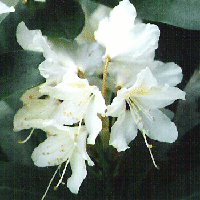 |
ERICACEAE - The Heath Family
This is a family of around 3000 apecies in 100 genera, found all over the world except Australia. Almost half of them are in the genus Rhododendron, coming mainly from China, and there are around 500 species of Erica, most of them from Southern Africa. This is a family mainly of shrubs or climbers, and almost all of them are found in acidic habitats, and are dependent on fungal mycorrhiza. Most are grown for ornament, often as hedges, including Gaultheria and Pernettya, although the leaves of Kalmia species are poisonous to stock and humans. In Britain, acidic moorlands are often covered in wild heather (Calluna and Erica species). The fruits of a few species, e.g. Bilberry (Vaccinium myrtillus) and Bog Whortleberry (Vaccinium uliginosum) are edible, but only the Cranberry (Vaccinium oxycoccos) is cultivated for this purpose. |
Characteristics of this Plant Family:
Leaves, Stem & Roots ~ Many members of this Family are evergreen shrubs or climbers, with woody stems. The leaves are simple without stipules, usually alternate, and are often thick, leathery and shiny. Species growing in dry conditions often have thin needle-like leaves.
Flowers ~ There is a calyx or four or five sepals joined at the base. The flower has four or five petals, usually joined to form a tube or trumpet. There are usually twice as many stamens as petals, and they are not attached to the corolla. There is a single style. The flowers are usually in clusters or spikes, but may be solitary.
Seeds ~ The ovary is usually superior but may be inferior. The fruit is usually a capsule or a berry.
Members of this Family usually have:
Woody stems
Simple evergreen leaves growing alternately
Clusters of flowers
Flowers with 4 or 5 petals forming a tube or trumpet
Stamens not attached to the flower tube
and are found in acidic conditions.